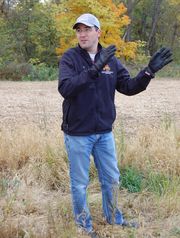The first year that prairie strips were strategically planted in corn and soybean fields near the Neal Smith National Wildlife Refuge, they worked to reduce loss of nutrients that can impair water quality, says Matt Helmers, an agricultural and biosystems engineer at Iowa State University.
“Things like plant diversity — the diversity of the prairie — have changed over time, evolved and enhanced,” Helmers said. “But water quality, we saw real benefits right from the beginning. It was surprising. We weren’t sure we’d see dramatic benefits.”
Those dramatic benefits Helmers and other researchers discovered: Converting just 10 percent of a crop field into prairie could reduce by 95 percent the soil and sediment leaving the field. Phosphorus loss decreased by 90 percent, and nitrogen loss by 85 percent. And the prairie created a habitat for pollinators, birds and animals.
What happens is that the “thick-stemmed vegetation” that comes with a prairie’s native grasses, flowers and other plants “slows down the flow of water and allows the water to infiltrate.”
Researchers are looking at four different row crop and prairie configurations in 12 sloping fields. One treatment is all corn or soybeans, another is 10 percent prairie at the foot of the slope, another adds a few prairie strips to the field with prairie at the foot, totaling 10 percent prairie, and the last adds strips to the foot slope, totaling 20 percent prairie.
About a dozen state and federal conservation and agricultural agencies are participating in the project, including the Leopold Center for Sustainable Agriculture.
With Iowa under pressure to reduce the amount of nitrogen and phosphorus that enters the state’s waterways and eventually contributes to the Gulf of Mexico’s dead zone, Helmers talked about how the research program — officially called Science-based Trials of Row-crops Integrated with Prairie Strips — fits into the state’s plan to reduce water pollution.
For the full Des Moines Register article, click here.
